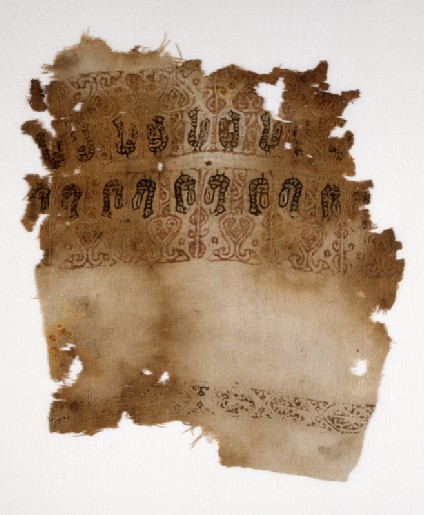Browse: 154 objects
- Reference URL
Actions
Textile fragment with peacocks and heart-shaped trees
-
Details
- Associated place
-
Near East (place of creation)
- Material and technique
- linen, embroidered with coloured silk
- Dimensions
-
27 x 24.5 cm max. (length x width)
along length/width 15 / 16 threads/cm (thread count)
ground fabric 0.05 cm (thread diameter)
additional fibre, embroidery 0.04 cm (thread diameter)
- Material index
-
organic › animal › animal product › silk,
- Technique index
- Object type index
- No. of items
- 1
- Credit line
- Presented by Professor Percy Newberry, 1941.
- Accession no.
- EA1993.248
-
Further reading
Ellis, Marianne, Embroideries and Samplers from Islamic Egypt (Oxford: Ashmolean Museum, in association with Greenville: Curious Works Press, 2001), no. 4 on p. 15, illus. p. 15
Kühnel, Ernst, Islamische Stoffe aus ägyptischen Gräbern in der islamischen Kunstabteilung und in der Stoffsammlung des Schlossmuseums (Berlin: Ernst Wasmuth, 1927), cat. 52, pl. 29
Barnes, Ruth and Marianne Ellis, ‘The Newberry Collection of Islamic Embroideries’, 4 vols, 2001, Oxford, Ashmolean Museum, cat. p. 209 (vol. iv), illus. vol. iv p. 209
Location
-
- currently in research collection
Objects are sometimes moved to a different location. Our object location data is usually updated on a monthly basis. Contact the Jameel Study Centre if you are planning to visit the museum to see a particular object on display, or would like to arrange an appointment to see an object in our reserve collections.
Publications online
-

Embroideries and Samplers from Islamic Egypt
Here pairs of small lively peacocks stand facing each other underneath trees stylised in similar fashion to those on the previous fragment [EA1984.508]. Again, there are two bands placed so that one is a mirror-image of the other. The stitch is the same as No.3 [EA1984.508], but on this piece split stitch is used both for outlining and filling in the shapes of the little peacocks with red, blue and yellow silk, which has now faded. Birds were not the only creatures chosen to decorate this category of early Fatimid embroidery. On another piece in the collection, four-footed creatures with raised left front paws, possibly lions, stand against a blue background. On yet another there is an elephant that must have once looked splendid with its pink head and legs, yellow body and large eye. These embroideries are most probably from furnishings. From documents recovered from the Cairo Genizah, a collection of medieval Jewish traders' documents found in the synagogue in Old Cairo, we learn that ten linen cushions were part of the dowry of a bride recorded about A.D. 1020. Although some of the Newberry fragments are sadly worn, enough have survived to give us some idea of the colourful embroidery that once brightened Fatimid homes. -

The Newberry Collection of Islamic Embroideries
A double band with a repeating design of tall plants alternating with pairs of confronting birds standing at the foot of a heart-shaped tree; remains of narrow band of hexagons.
Kuhnel dates a similar embroidery to the 12th/13th century.
© 2013 University of Oxford - Ashmolean Museum

